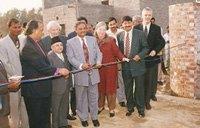Integrated Sanitation and Farming System
In partnership with UNICEF, IBADAT launched the ISFS Model Farm in Lahore offering the nearby village basic knowledge to gain a substantial degree of sustainability and to improve the overall health and well-being of the people. This same assistance has been offered through seminars/training workshops to a Christian agricultural community.
Integrated Sanitation & Farming System is a system that utilizes all given, natural resources optimally with integration to one another and maintains sustainable sanitation as well. It re-uses all organic waste with particular natural process. The salient features and emphasis of ISFS has been:- Treatment and recycling of waste water from the village, making it usable for irrigation purposes.
- Treatment of animal waster with production of biogas and mineralized effluents.
- Poultry farming on organic byproducts.
- Planting of trees, contributing to improve quality of life, reforestation and increasing family income.
- Production of Lemina (duckweed) associated with poultry farming.

Opening ceremony by Mr. Derek Cyprian – Federal Minister for Minority Affair, Tourism, Culture and Sports
Waster water treatment
At present sewerage water comes from the nearby village and is collected into a small pond with the EM pond – Developed after years of research by Japanese and American scientists, Micro Electro-organisms (EM) in liquid rid the water of calcium, potassium and magnesium, nitrogen and chloride. It also removes the foul smell of sewerage water.
After treatment with EM the water is transferred to a shallow pond, where the water is moved by paddle wheels. Lemina and Hyacinth algae are grown to dissolve organic components by intense oxidation, making the water clean for irrigation purposes. It is not clean enough for human consumption.
Later on the algae are collected, partly dried and used for compost or animal feed. The climate is excellent for the process.
The model is also adaptable to kitchen gardens, using waste water as a source of nutrients and obviously a solution for many villages where sanitation is a big problem.
Slurry pond
Slurry comes from the biogas digester and is stored in a pond where treated water is mixed and used for organically grown vegetables and fruit trees. Slurry serves as a natural fertilizer.
Fish
There is a small fish pond for demonstration purposes. At present there are four kinds of fish: silver carp, grass carp, Rahu and Thela, weighing from 400 grammes to 2 kg. Their entire period of growth is closely monitored. The fish feed is mainly based on grass and vegetables etc. grown on the farm. It provides farmers with an alternative food source rich in protein at no extra cost.
Biogas Digester
At present there is a Chinese style iron-drum system. The dung of three animals is used. The digester then produces methane gas which is sufficient for one family’s heating and cooking needs. The digested waste known as slurry is collected into the slurry pond (mentioned above).
Poultry Farming
A small poultry farm of about 100 layer birds is also maintained for demonstration purposes. Quails are also reared with the poultry.
Honey bee farm
Honey produced in this way provides another excellent food supplement.

